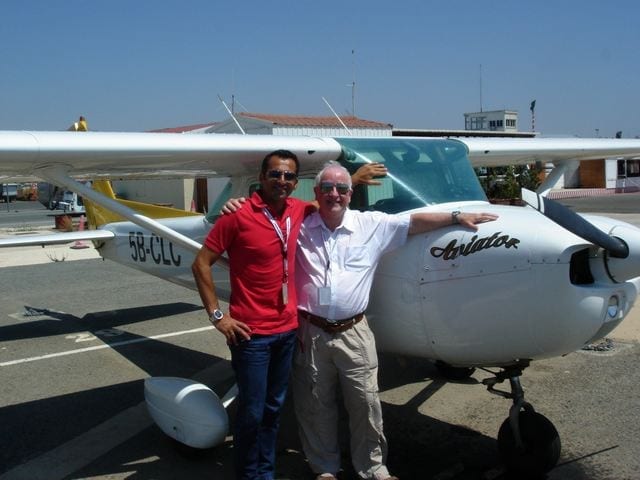Occasionally, while training pilots who have booked practice sessions because of forthcoming interviews and simulator assessments, I have started, “How about we first do some circuits and landings?”
Some immediately go heads down into the computer display, typing a circuit with downwind waypoints, base leg turning points and final intercepts. Finally, a work of art, like a Pablo Picasso painting, is built up on the computer screen. After that, all the pilot needs to fly a perfect circuit is to keep the flight director needles centered.
Well that is the theory, of course.
Each booking is usually for one hour and, because simulator time is expensive, every minute wasted in unnecessary actions is money out of their pocket. As their fingers flash over the keyboard, I gently remind them they have already lost five minutes of flying practice when all that was needed was an HSI, ADI, altimeter and ASI to fly the aeroplane.
Yet, many of today’s pilots are usually so addicted to the automatics, that the thought of switching off the autopilot and flying manually is practically a Mayday situation. These pilots may already have hundreds of hours on 737s with most of the time on autopilot and flight director. Yet, when coaxed into switching off the automatic features and told to fly by looking out of the cockpit on the downwind, base and final leg, afterwards the almost universal reply is “Jeez – I enjoyed that – I haven’t done circuits since flying a Cessna 172.”
Many years ago, I was a contract captain with a German charter operator based in Hamburg, Germany, flying the 737-400 and 500 with German first officers. It was there that I crewed with my first female first officer. She was relaxed after flying with other British contract captains as they seemed less strict than their German counterparts.
We were flying back from Spain into Hamburg on a beautiful moonlit night and I was mesmerised at the sight of all the city and village lights over that part of Europe. The final track to Hamburg was by coincidence lined up with the duty runway from 100 miles out and Anya as Pilot Flying (for that was her name) had everything set up in the FMC and of course the automatics did a good job.
Top of descent came up on the screen and my mind went back to the long straight-in approaches I had done into Pacific island atolls in my previous job. In those days, we used the venerable 737-200. There was no FMC and we simply used DME vs. height to fly the descent on profile. Our aircraft had a FD108 flight director but most of us never bothered to use it. It became a matter of personal pride to fly the descent profile without resorting to use of the speed brakes. There was a satisfying sense of achievement if all worked out nicely to over the fence, on slope and on speed.
“Anya,” I said at 100 DME Hamburg straight ahead, “How about you take out the automatic pilot and fly a profile descent straight into Hamburg with no flight director and no autothrottles?” Anya wasn’t sure what I meant, probably because being German, English was her second language and I talked too fast anyway. “You know, DME vs. height or three times the height plus 10,” I said.
Anya looked aghast at my suggestion and covering the cockpit voice recorder with one hand, she whispered “Shhh.” She seemed scared of Big Brother.
With some cajoling and promising not to tell anyone about this shocking decision not to use LNAV and VNAV, I talked Anya into the descent profile, manual flying, manual throttle and FD off. From 100 miles out she flew it beautifully all the way to touch-down with just a little help from me with flap/speed control towards the end. A greaser landing topped it all off and we heard the passengers clapping in admiration (or was it relief) at Anya’s smooth landing.
As we taxied towards the Hamburg Terminal, Anya looked over at me said, “Now that was real flying, wasn’t it? And thank you very much, but please promise me you won’t tell anyone, will you?” pointing to the CVR microphone.
“I won’t tell a soul, Anya, and you flew beautifully,” I replied.
Now 25 years later I have broken my promise. If Anya happens to read this story, I know she will understand and forgive me.
- Like overtaking on a blind corner and hoping nothing is coming the other way - June 17, 2019
- Flight directors – a fatal attraction - April 18, 2018
- The day I learned I’d never be a fighter pilot - September 22, 2016














Speaking of large planes doing circuits. When I was doing my dual cross county way back in September 1980, we landed at London(Ontario) airport. My instructor wanted to show me around a bit so we went up to the FSS which had a nice view of the airport and the main runway which was right in front of us. By the time we got up here an Air Canada L-1011 had started to do circuits. It was quite a site seeing it doing touch and go’s and flying low as it completed the circuit.
There are few better ways to introduce yourself to a new aircraft type, than traffic pattern work. Lots of large excursions in power, pitch, and airspeed; configuration etc. All in a fast-paced routine that makes the most of every minute of stick time. Great opportunity to figure out how to fly the thing with precision.
Great story … well written … and very a propos given the recent tragic loss of so many lives and injuries due to lack of very basic flying skills. You’d think some of the bean counters who run airlines these days would take notice. I’m reminded of the old flight safety mantra … if you think adequate flight training is too expensive try having an accident.
Too bad this is not the flight training required by all airlines today. Good story about the way training should be done. I, of course, understand the bean counters now in charge of airlines don’t understand the realities of flying these big monsters, and that’s a shame.
I worked for a retired USAF KC-135 instructor pilot, and was lucky enough, (even before getting my PPL,) to get an hour in their full motion simulator before it was moved to another base, he told me he never let his students fly autopilot, except in full session (8 hour) sessions, where they had to fly a complete mission. Talk about fun!
It’s sad commentary that hand-flying the pattern or performing a descent and landing without automation is considered illicit, unusual, or risky. But for more and more people — jet drivers and light GA folks alike — it is.
VanderBurgh never gets old. In my previous airline, flying the 737, wouldn’t be that big deal if something went weird with the magenta and you just turned it all off and carried on. Handflown circling to land 700ft above the ground at 2am, some visual patterns here and there. And it was already very restricted. But with RNAVs, the visuals are seldom more fuel efficient, not to mention the outrageous GPS visual guidances – for me much harder to follow than simply flying visually. Automation is king for reducing both PF and PM workload, especially in busy airspaces, and a very good excuse is needed to do otherwise. Although some attention has been brought to it during the simulator sessions lately, it is very hard to see us turning back to yesterday, and some golden skills are gonna get lost in the process. It is a fight that worth being fought. But honestly I don’t know how to do it. But the glide math? Oh yeah… with crazy vectoring is always useful, despite some nice resources like the offpath descent feature in the FMC. I use 4×1 in the heavy plastic, the 200 tons glider…